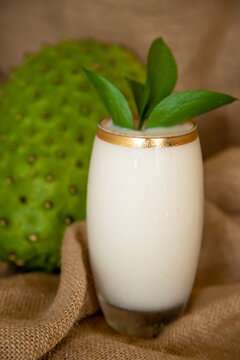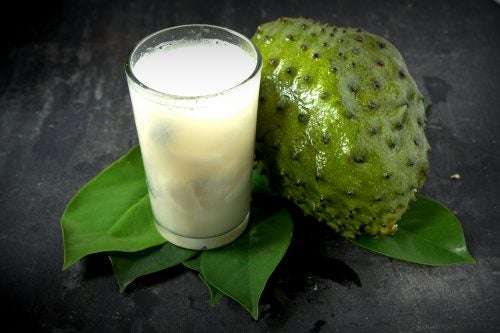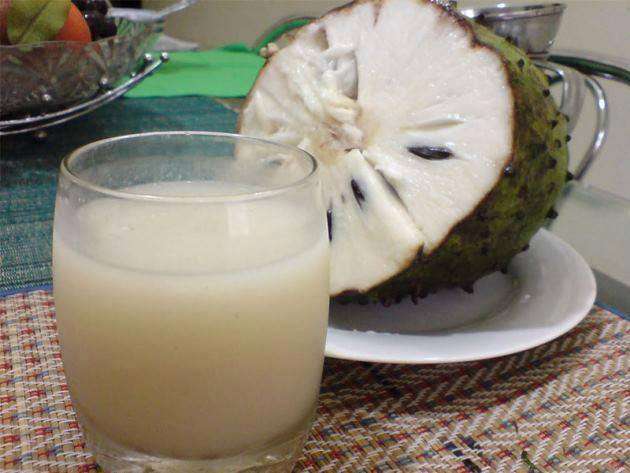You just need to take a few minutes and you will have a delicious and nutritious guanabana juice right away for hot days.

The unassuming guanabana fruit, which is quite popular in our nation and is most frequently used to make champola de guanabana, is also known as a soursop (soursop juice). A delightful, marvelously sweet, cold beverage is the end result, which is ideal for satisfying your thirst on a hot day.
This guanabana juice is creamy, little acidic, and minty. It is also incredibly cooling. If you’ve ever eaten a guanabana and enjoy it, this drink will undoubtedly satisfy your craving. To balance out the final product, this juice also contains a small amount of mint and some bananas in addition to the guanabana. This cocktail is incredibly simple to make and tastes especially good cold.

What is sour fruit?
The annona muricata tree, which belongs to the annonaceae family and is native to South and Central America, the Caribbean, and other tropical areas of the Americas, produces the tropical fruit known as the guanabana or soursop. The soursop fruit is enormous (about the size of a papaya), green even when ripe, and contains huge black seeds as well as a milky-white mushy pulp with a creamy texture.
The cherimoya and the guanabana fruit are similar in both appearance and flavor.
Gains from guanabana
The guanabana fruit, often referred to as soursop or graviola, is a well-liked treat throughout the Caribbean. It is adaptable and can be consumed either raw or pureed into a thick but hydrating juice.
Numerous health advantages of sour fruit. The fruit is full of fiber and vitamin C, which improves immunity, facilitates digestion, and advances general health. Most intriguingly, potent anti-cancer capabilities have also been linked to soursop.
Similar to the fruit, soursop leaves have a number of health advantages. As a result, Jamaicans frequently drink guanabana leaf tea as a home cure to soothe anxiety and promote restful sleep.

How to Pick the Best Guanabana Fruit for Juice
A completely ripe guanababa is the ideal for juicing. Don’t worry; I’m here to help if you’ve ever tried to produce guanabana juice but your soursop wasn’t quite right. I’ll explain how to pick the best sour plum to juice.
To get the most out of your guanabana, whether you buy it from a store or a tree, follow my advice in the section below. Here are my suggestions for picking the ideal sour fruit for juicing:
• Look at the guanabana’s skin. It may be under-ripe and won’t ripen correctly no matter how long you keep it if it is very green, firm, and shiny. Additionally, check your soursop for any bruising, holes, or tears. Soursops with damaged skin that is exposed to microorganisms will rot quickly.
• Take note of the “spikes.” If the soursop spikes are extremely lengthy and closely spaced, the fruit is too “young.” Choose soursop that is slightly delicate to the touch and with spikes that are widely spaced apart (see photo above).
• Trust your instinct. Does the guanabana look unusual or amusing? Perhaps you can’t exactly understand it. Does it have a strong “sour” odor? Do little flies swarm the soursop? Does it have a number of weak points? That might indicate that the soursop is rotting and overripe, so you shouldn’t buy it.
Developing guanabana juice
If your guanabana isn’t yet ripe, you can hasten the process by covering it in newspaper or a paper bag. Once it has been wrapped, keep it on the counter and check it every day. Your guanabana is ripe when it is soft all around. The color of the skin is another indicator of an ideal ripe guanabana juice. The color of the soursop’s skin should go from a vibrant green to a drab or greenish-brown hue. Your guanabana is ready to be juiced at that point!
Ingredients
There are only 3 ingredients in this juice! Even if soursop is not always simple to locate, you should put this drink at the top of your list of things to accomplish if you do.
Instructions
The removal of all the black seeds from the soursop is the first and most crucial step in preparing the juice. It is alleged that these seeds contain harmful substances and are therefore unsafe for consumption.
Given that the fruit will be mixed, it is crucial to remove them. The black seeds are contained in tiny pouches in the fruit, which can be easily opened by giving them a press.
I feel that using my fingers makes it simpler, so once you’ve washed and cleaned your hands, you can move on. Use gloves as an alternative. Bananas should then be divided into smaller pieces.
Bananas, soursop (seedless! ), and mint should all be added to the blender and mixed until smooth.
After putting the mixture through a sieve, serve it cold.

Tip
Save the fruit pulp for a smoothie or your fruit bowl once you strain the mixture through the strainer. You could also choose not to filter the mixture and obtain a lovely soursop smoothie. Adding more fruits is an option, and my advice would be to go with those that aren’t extremely tart or acidic.
You’ll be happy to learn that my sourdough recipes are adaptable, so feel free to swap out brown sugar for honey or any other preferred organic sweetener.
Try my recipe for naturally lime-flavored guanabana juice if you’re watching your weight, have health issues, or just don’t like milk-based drinks. It’s not only easy and energizing, but also very healthful. To enjoy the version of the guanabana Juice drink, try juicing the Soursop, adding just a spritz of lime, and forgoing any sweets.
FAQS
Is it okay to eat a guanabana fruit?
Guanabana is typically safe to eat, but the seeds should not be consumed. In this recipe, we tell you to take them out before juicing the soursop.
What uses does guanabana juice have?
The juice of a soursop is a tasty, healthy beverage that is ideal for a mid-afternoon snack.
Is the fruit guanabana sweet?
Guanabana can be quite sweet, which makes it ideal for sweets and milkshakes.
After this article, you must have known more about guanabana as well as how to make a delicious and nutritious guanabana juice. Good luck on your first juice making. Wishing you good health!
